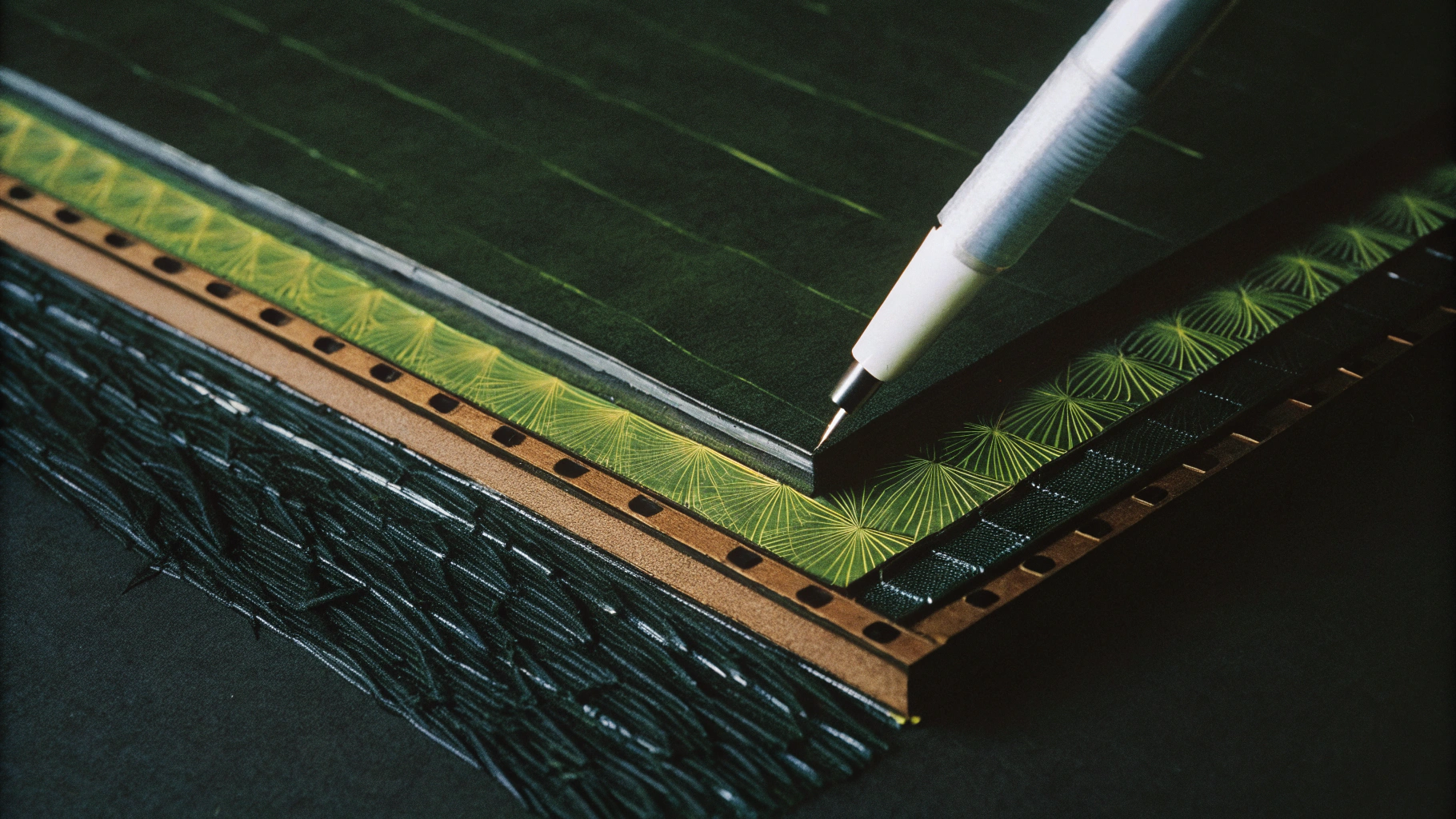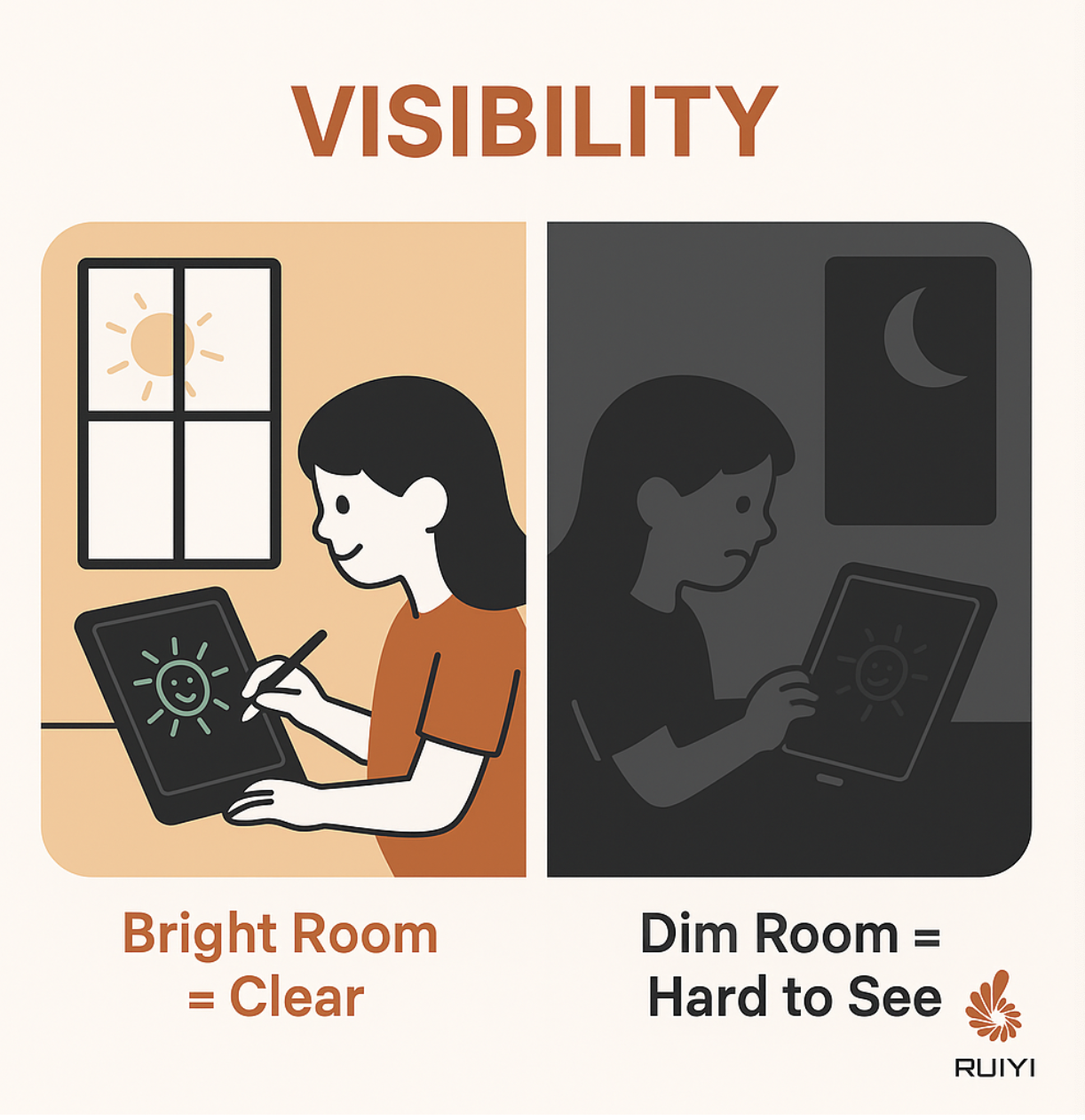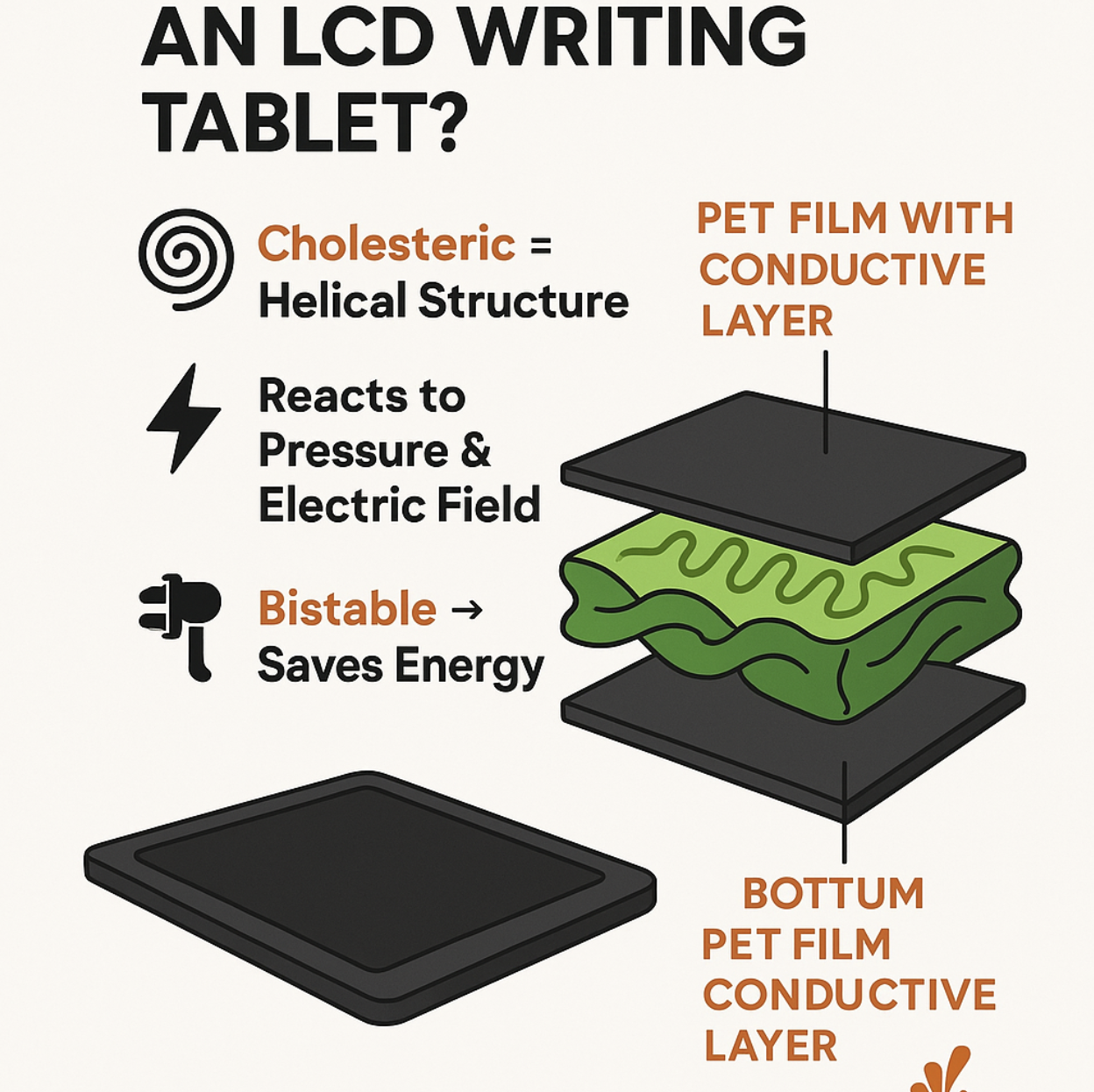What is the technology of LCD writing tablet?
Tired of paper clutter and dried-up markers? Want a simple, eco-friendly way to jot notes or let kids draw? LCD writing tablets offer a clean, reusable solution.
The core technology in an LCD writing tablet is called Bistable Cholesteric Liquid Crystal Display (ChLCD). Pressure from a stylus rearranges special liquid crystals to reflect light, creating visible lines. It holds the image without power, only needing a small burst to erase.
That’s the quick answer, but it probably leaves you wondering exactly how pressing a plastic stick on a screen makes a line appear like magic. It’s simpler than you might think, yet quite clever. Let’s dive into how these tablets actually work.
How does the LCD writing tablet work?
Curious how writing appears instantly on an LCD tablet without any ink? It looks simple, but there’s smart technology inside making it all happen. Let’s break it down.
When you press the stylus onto the screen surface, it forces the liquid crystals underneath into a specific alignment. These aligned crystals reflect ambient light, making your writing or drawing show up clearly against the dark background.
!
Let’s look a bit closer at the process. Imagine the screen as a sandwich. There’s a tough, clear top layer you write on. Beneath that is the active layer: a special polymer film holding tiny droplets of liquid crystals. Underneath that are conductive layers and finally, a dark backing layer to provide contrast.
When you write, the pressure from your stylus physically pushes on the top layer. This pressure squeezes the liquid crystal droplets directly underneath the stylus tip. This force changes the structure of the liquid crystals inside those droplets, moving them from a jumbled state (which doesn’t reflect light well) into an ordered, layered state (planar texture). This ordered state strongly reflects ambient light entering from the front. Because the backing is dark, the reflected light stands out, and you see a line!
One of the coolest parts is image retention. Thanks to the bistable nature of these specific liquid crystals (we’ll touch on that next), they stay in that light-reflecting state even after you lift the stylus. No power needed to keep the image visible!
So how does it erase? Pressing the erase button sends a tiny electrical voltage across the conductive layers sandwiching the liquid crystals. This electrical field scrambles the liquid crystals back into their original, non-reflective state (focal conic texture), making the screen appear dark again. As manufacturers with 10 years focused on this product, we know the quality of this liquid crystal film and the conductive layers is absolutely key for bright writing and reliable, complete erasure.
| Here’s a simple breakdown: | Step | Action | Crystal State | Visual Result |
|---|---|---|---|---|
| 1. Standby | No pressure | Focal Conic | Dark Screen | |
| 2. Writing | Stylus pressure applied | Planar | Visible Lines | |
| 3. Retention | Pressure removed | Planar (stable) | Image Remains | |
| 4. Erasing | Erase button pressed (zap) | Focal Conic | Screen Clears |
What is the technology behind LCD?
The term LCD often makes people think of TVs or computer monitors. But the tech in a writing tablet is different and simpler. What makes it tick?
The specific technology is Bistable Cholesteric Liquid Crystal Display (ChLCD). Unlike typical LCDs needing constant power and backlights, ChLCDs only use power briefly for erasing. They display images by reflecting ambient light, holding the image state stably.
Let’s unpack "Bistable Cholesteric Liquid Crystal Display".
- Liquid Crystals: These are fascinating materials existing in a state between a conventional liquid and a solid crystal. Their molecules can flow like a liquid but tend to align in specific, ordered ways like crystals.
- Cholesteric Phase: This is a specific type of liquid crystal where the molecules arrange themselves into layers, with the alignment direction twisting slightly from one layer to the next, forming a helical structure. This helical structure is key to its optical properties, particularly how it interacts with light.
- Bistable: This is the magic ingredient for writing tablets. "Bi-stable" means the liquid crystals can exist stably in two different states without continuous power.
-
- Planar State (Reflective): Achieved by pressure. The helical structures align parallel to the screen surface, strongly reflecting ambient light of specific wavelengths (often appearing greenish or bluish). This makes the writing visible.
- Focal Conic State (Non-Reflective): The default state, or the state after an electrical pulse (erasing). The helical structures are randomly oriented or jumbled, scattering light weakly, making the screen appear dark.
This is very different from the LCDs in your phone or TV, which typically use Nematic liquid crystals, require constant power to maintain an image, and need a backlight to be visible. ChLCDs are much simpler and more energy-efficient, making them perfect for portable writing devices. The battery in an LCD writing tablet (usually a small coin cell) lasts for ages because it’s only used for the brief electrical pulse during erasing. This efficiency and simplicity is why we love using this tech for creating eco-friendly, safe, and durable writing tools, especially for kids. We ensure we use high-quality ChLCD film for the best contrast and lifespan.
Key Features of ChLCD in Tablets
- Bistability: Image stays put with zero power draw.
- Reflective: Uses room light; no bright backlight needed (easy on the eyes).
- Pressure Sensitivity: Simple mechanical force creates the image.
- Low Power: Battery lasts months or years, only used for erasing.
-
What are the disadvantages of LCD writing tablets?
These tablets are handy, but are there any downsides? Knowing the limitations helps you decide if it’s the right tool for your needs. Let’s be upfront about them.
The main drawbacks are typically the lack of a backlight (making it hard to see in dim light), no built-in way to save your work digitally on basic models, usually only full-screen erase (no undo), and a monochrome display.
Let’s look at these points more closely:
- Visibility: Because they rely on reflecting ambient light, they work best in well-lit environments. In a dark or dimly lit room, the screen will be hard to see, unlike your phone or a backlit tablet.
- Saving Work: Standard LCD writing tablets are like digital chalkboards – once you erase, it’s gone forever. There’s no internal memory or "save" button. The common workaround is just taking a photo of the screen with your phone. Some newer, more expensive models offer Bluetooth syncing with apps, but this adds complexity and cost, moving away from the core simplicity.
- Partial Erase: Most models have a single erase button that clears the entire screen. You generally can’t erase just one mistake. This can be frustrating if you make a small error in a large drawing or list. (Recognizing this limitation is partly why we developed our new Magnetic Nanocapsule Whiteboard, which does offer partial erase).
- Color: The writing is typically monochrome – usually a greenish-blue line on a dark background. Some "color" or "rainbow" models exist, but they achieve this by having different color-reflective segments pre-set in different zones of the screen, not by allowing you to choose or mix colors dynamically.
- Accidental Erasure: The erase button can sometimes be pressed by accident, leading to lost work. To prevent this, many models, including many of ours at Ruiyi Plastic, include a crucial little ‘lock’ switch on the back or side that disables the erase button.
Understanding these limitations helps manage expectations. For quick notes, temporary lists, kids’ drawing practice, or drafting ideas, they are fantastic. For permanent records, complex color work, or use in the dark, other tools might be better.
| Limitation | Description | Possible Solution/Our Offering |
|---|---|---|
| No Backlight | Hard to see in low light | Use in well-lit areas; Consider backlit tablets (different tech) |
| No Saving | Cannot store notes digitally | Photograph screen; App-sync models; Use different device |
| No Partial Erase | Entire screen clears at once | Plan erasing; Check for lock switch; Our Magnetic Whiteboard |
| Monochrome Display | Limited color options | Accept simplicity; Rainbow models (segmented); Other devices |
| Accidental Erase | Easy to lose work | Use models with lock switch (many of ours have this) |
Which liquid is used in an LCD writing tablet?
We’ve mentioned "liquid crystals" a lot, but what exactly is this substance? Is it safe, especially if kids are using these tablets? Let’s clarify the material inside.
LCD writing tablets contain Cholesteric Liquid Crystals. These are special organic compounds suspended as droplets within a thin polymer film, which is safely sealed between layers of plastic making up the screen.
The term "Cholesteric" relates to cholesterol because some of the first liquid crystals discovered with these properties were derived from cholesterol esters. Today, many synthetic organic compounds are used that exhibit the same unique cholesteric phase behavior – that helical structure sensitive to pressure and electric fields, and capable of bistability.
Crucially, these liquid crystals1 are not sloshing around freely. They are micro-encapsulated or dispersed within a solid but flexible polymer matrix (like being suspended in a very thin sheet of clear jelly). This entire active layer is then sandwiched securely between two sheets of durable plastic film (often PET, the same plastic used in drink bottles), which usually have transparent conductive coatings on their inner surfaces.
Is it safe? Yes. The liquid crystal material itself is sealed away and not accessible during normal use. The amounts are tiny, and the materials are chosen to be stable and generally non-toxic. As manufacturers deeply committed to safety, especially for products often used by children, we ensure our tablets meet stringent international safety standards. Our factory holds certifications like CE EN712 (European toy safety), CCPSA (Canadian consumer product safety), CPC (Children’s Product Certificate in the US), and RoHS3 (Restriction of Hazardous Substances). These certifications mean the materials used have been tested and are considered safe for their intended use. With our decade of experience producing these specific items, safety and material quality are always top priorities for us at Ruiyi Plastic.
Inside the Screen Sandwich:
- Top Layer: Tough, transparent plastic (e.g., PET) for writing on.
- Active Layer: Polymer matrix film containing the Cholesteric Liquid Crystal droplets.
- Conductive Layers: Transparent conductive material (like Indium Tin Oxide – ITO) on plastic substrates.
- Backing Layer: Dark opaque material to absorb light and provide contrast.
Conclusion
So, LCD writing tablets use clever Cholesteric Liquid Crystal technology for simple, ink-free writing. They reflect light, hold images without power, and erase with a button press. While limited by visibility and saving options, they offer a fantastic, eco-friendly paper alternative.
-
Explore this link to understand the fascinating properties and applications of liquid crystals in various technologies. ↩
-
Learn about CE EN71 certification to see how it ensures safety in children’s toys and products, crucial for parents and manufacturers alike. ↩
-
Discover the importance of RoHS certification in ensuring products are free from hazardous substances, promoting safety and sustainability. ↩
You may also be interested in:
Contact Us
Phone
+86 18975761579Website
ruiyiboard.comAddress
Shenzhen Longhua, Guangdong, China
Shenzhen Ruiyi Plastic Products Co., Ltd. is a professional manufacturer focused on eco-friendly writing products since 2016.
Our mission is to provide paper-free, ink-free, safe and environmentally friendly electronic writing solutions.



